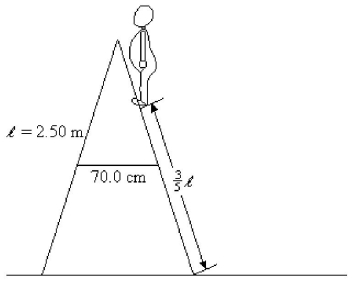A stepladder consists of two halves,hinged at the top,and connected by a tie rod that keeps the two halves from spreading apart.In this particular instance,the two halves are 2.50 m long,the tie rod is connected to the center of each half and is 70.0 cm long.An 800-N person stands 3/5 of the way up the stepladder,as shown in the figure.Neglecting the weight of the ladder,and assuming that the ladder is resting on a smooth floor,what is the tension in the tie rod? Note: To solve this problem you must "cut" the ladder in half and consider the equilibrium of forces and torques acting on each half of the ladder. 
Definitions:
Trypsinogen
An inactive enzyme precursor produced in the pancreas, that, once activated to trypsin, plays a key role in the digestion of proteins in the small intestine.
Cholecystokinin
Cholecystokinin is a hormone produced by the cells of the duodenum, involved in stimulating the digestion of fat and protein by triggering the gallbladder to release bile and the pancreas to secrete enzymes.
Gallbladder
A small, pear-shaped organ located beneath the liver, which stores and concentrates bile, a digestive fluid produced by the liver.
Hormone
Chemical messengers produced by endocrine glands that regulate various body functions, including growth, metabolism, and mood.
Q5: A 20.0-kg uniform plank is supported by
Q5: You push downward on a box at
Q8: 1)000 L of water at 20.00°C will
Q9: The figure shows a pV diagram for
Q31: An incompressible fluid flows steadily through a
Q33: A uniform meter stick is freely pivoted
Q38: A 12.0-N object is oscillating in simple
Q42: A 12,000-N car is raised using a
Q44: A small planet having a radius of
Q52: A 1000-kg car is slowly picking up